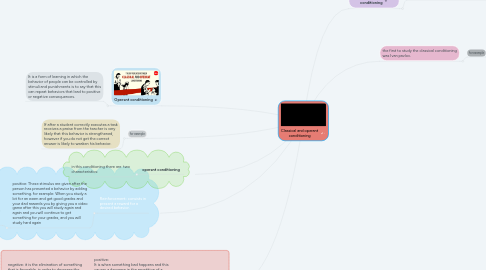
1. punishment: consists in present a reward for an undesire behavior
1.1. positive: It is when something bad happens and this causes a decrease in the repetition of a certain behavior. For example, a child is trying to grab an object that is on the table but when he wants to do it he gives himself a blow and this hurts or frightens them, the probability of repeating the mischief is reduced.
1.1.1. negative: it is the elimination of something that is favorable, in order to decrease the probability of that behavior reoccurring. Example: if you do not clean your house you do not go out to play soccer with your friends so the child will clean the house whenever they ask for it.
2. Reinforcement: consists in present a reward for a desired behavior.
2.1. positive: These stimulus are given after the person has presented a behavior by adding something. for example: When you study a lot for an exam and get good grades and your dad rewards you by giving you a video game after this you will study again and again and you will continue to get something for your grades, and you will study hard again
2.1.1. negative: It refers to the elimination of unfavorable stimulus after they exhibit some behavior. For example, when you leave for work and on the road you always find a lot of traffic, then the next day you leave earlier as a consequence of avoiding traffic and arriving early and what you continue doing during the next days.
3. for example
3.1. If after a student correctly executes a task receives a praise from the teacher is very likely that this behavior is strengthened, however if you do not get the correct answer is likely to weaken his behavior.
4. Operant conditioning
4.1. It is a form of learning in which the behavior of people can be controlled by stimuli and punishments is to say that this can repeat behaviors that lead to positive or negative consequences.
5. operant conditioning
5.1. in this conditioning there are two characteristics:
6. the first to study the classical conditioning was Ivan pavlov.
6.1. for example
6.1.1. When students are alone in the classroom and listen to a teacher approaching, they usually sit fast and be silent. The conditioning is because when they listen to a teacher they know that they should behave in that way
